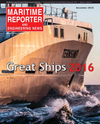
Page 28: of Maritime Reporter Magazine (December 2016)
Great Ships of 2016
Read this page in Pdf, Flash or Html5 edition of December 2016 Maritime Reporter Magazine
MARINE FUELS & EMISSIONS “It is not possible to determine from the study that there would be suf? cient fuel avail- able in 2020”
Photo: BIMCO
Lars Robert Pedersen, Deputy Secretary General, BIMCO concluded that suf? cient compliant fuel Ships can meet the requirement either cleaning systems or ‘scrubbers’, which and the US Caribbean Sea area (around oil would be available to meet fuel oil re- by using low-sulfur fuel oil or by using ‘clean’ the emissions before they are re- Puerto Rico and the US Virgin Islands).
quirements, was completed in 2016 and gas as a fuel, which, when ignited, emits leased into the atmosphere. In this case, submitted to MEPC 70, thus forming the negligible amounts of sulfur oxides, an the equivalent arrangement must be ap- Support for IMO basis of IMO’s decision to reduce the cap option being adopted by an increasing proved by the ship’s administration (the Contrary to BIMCO’s reaction, the to 0.5% by 2020, a signi? cant reduction number of ships. This has been recog- ? ag state). IMO proposals have been welcomed on the current maximum sulfur content nized in the development by IMO of its The new global cap will not change the by the European Community Shipown- limit of 3.5%, which has been in effect International Code for Ships using Gases limits in SOx Emission Control Areas ers’ Associations, its Secretary Gen- since January 1, 2012. The interpretation and other Low Flashpoint Fuels (the IGF (ECAs) established by IMO, which has eral, Patrick Verhoeven, commenting: of “fuel oil used on board” includes fuel Code), which was adopted in 2015. An- been 0.1% m/m since January 1, 2015. “These important decisions demonstrate used in main and auxiliary engines and other alternative fuel is methanol, which The ECAs established under MAR- the global leadership of IMO on regula- boilers, however exemptions are provid- is being used on some short sea services. POL Annex VI for SOx are: the Baltic tion of ship emissions. The mandatory ed for situations involving the safety of Ships may also meet the SOx emis- Sea area; the North Sea area; the North GHG data collection system will make the ship or saving life at sea, or if a ship sion requirements by using approved American area (covering designated it possible to de? ne what will be the or its equipment is damaged. equivalent methods, such as exhaust gas coastal areas off the US and Canada); contribution of international shipping 28 Maritime Reporter & Engineering News • DECEMBER 2016
MR #12 (26-33).indd 28 MR #12 (26-33).indd 28 12/5/2016 2:07:49 PM12/5/2016 2:07:49 PM

 27
27

 29
29
